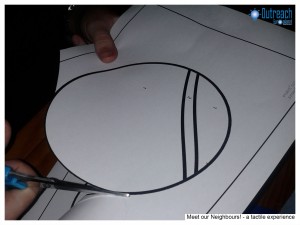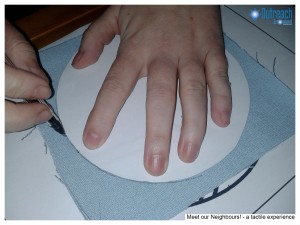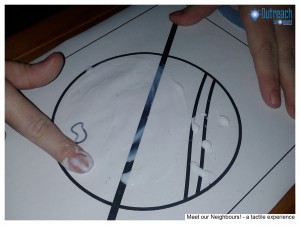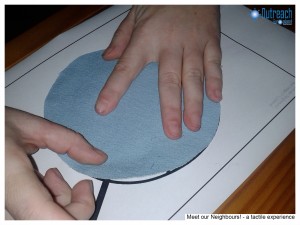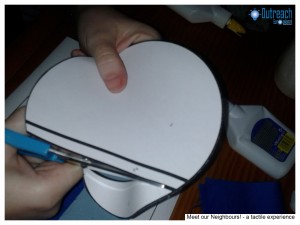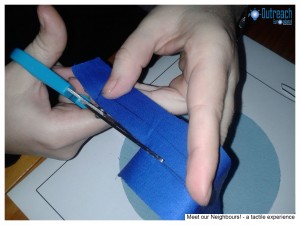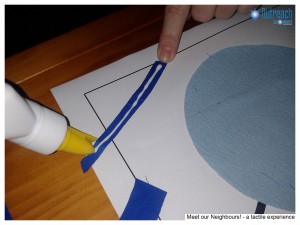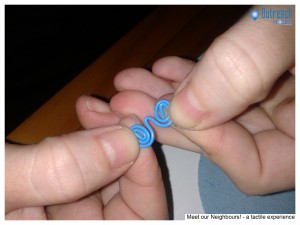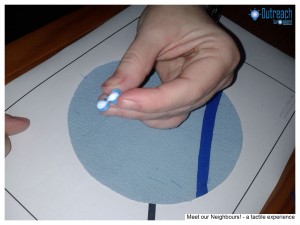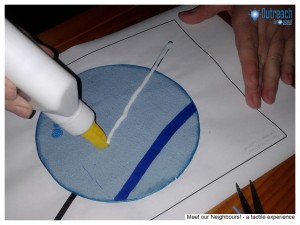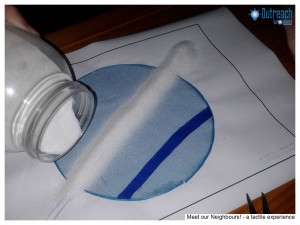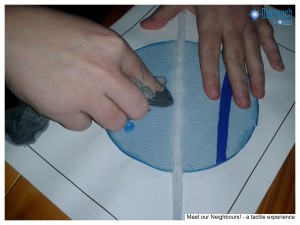:: Description ::
In this activity groups of visually impaired students and their sighted peers are invited to use daily basis items and recycled materials to build a tactile schematic image of a celestial object from our solar system. In a group activity they are also encouraged to research about our celestial neighbour and its main characteristics.
This activity is planned for groups of children from 6 to 12 years old and their educators gathered in groups of 3 to 5 children (for example three sighted children and two visually impaired). The activity can be implemented at three stages that can be done separately:
- Research on the celestial object by the children prior to the activity;
- Build the tactile image in a hands-on performed by the sighted children closely interacting with their visually impaired peers;
- Tactile exploration of the final schematic image by visually impaired children.
Variations of the activity can also be conducted. For instance, promote activities for sighted children in which they learn and build the tactile images and then promote explanatory sessions to their visually impaired peers.
In all stances, it is strongly advised to stimulate interactions between sighted children and their visually impaired peers.
:: Materials ::
- Thin fabric;
- Thick fabric;
- Sand;
- Black and white prints of image (x2) and mold (x1). Click links to Download.
:: The Scientist Explains ::
[General Information]
Uranus is the first planet to have been discovered in modern times. It was only discovered in 1781 by the British astronomer William Herschel. Its distance from the Sun is 2.88 million kilometers and it takes 84 years to complete its orbit. Its diameter is 50.700 km (4 times that of Earth) and its mass equals 14.5 times that of Earth.
Like Jupiter, Saturn, and Neptune, it is part of the giant gaseous planets which are mainly composed of hydrogen and helium, but its atmosphere and interior are richer in methane and probably in other heavier constituents like ammonia and water. The reason is that the rocky and icy core of the planet is proportionally larger in Uranus (and Neptune) than on Jupiter and Saturn, compared to the mass of the gas. It is also much colder (-215°C globally, compared to -150°C for Jupiter and -180°C for Saturn) because of its larger distance from the Sun.
[Tactile features]
[While you explore the tactile schematic image you can find:]
As a consequence, the atmosphere seems to be in a frozen state, with very little meteorological activity, and very few clouds (made of frozen methane) and storms (materialized by twisted wire and cotton on the tactile image) are visible on the face of this quiet frozen world.
The most particular feature of Uranus is that, contrary to all the other planets, its axis of rotation is not perpendicular (or nearly perpendicular) to its orbit around the Sun, but rather inclined. The cause of this very inclined rotation axis is not known. One of the hypotheses is that Uranus collided with an object the size of Pluto during the first hundreds million years of its history. A more recent theory is that a natural satellite became unstable and changed the orientation of the rotation axis through its gravitational influence, then later escaped the attraction of the planet.
One of the consequences of the inclined axis is that the poles are alternately in darkness (or in sun light) for very long periods, close to 40 years. Also, the mid-latitude and equatorial regions receive on average much less sunlight than if the pole were upright on the orbit. Over the last twenty years or so, these regions have been getting more and more sunlight and have begun to show some convective activity (warmed up air moving upwards). Some banded structure (materialized by the strip of fabric near the pole on the tactile image) has also begun to appear like on Jupiter and Saturn.
Uranus has a very tenuous ring system (materialized by the glued-on sand on the tactile image), which was discovered in 1977 by observing a star while the planet passed in front of it. These rings are made of very dark material and can only be observed with powerful telescopes or from a spacecraft passing near the planet.
Uranus is surrounded by lots of natural satellites, the largest being Titania.
:: Full Activity Description ::
Prior to the activity:
- Gather the children in groups of 5 elements – visually impaired and non-visually impaired (ideally 3 non-visually impaired to 2 visually impaired);
- Present one image per group;
- Distribute materials accordingly;
During the activity:
- Close supervision – follow each group and explain each of the tactile elements and their correspondence to the each object feature;
- Understand the different needs of each group of students to promote interaction between the children during the building of the tactile image – visually impaired children need to be familiarized with the different materials involved;
Building the tactile image:
STEP 1: Print image 010_Uranus_Image.pdf and 010_ Uranus_Mold.pdf, in a regular black and white printer;
STEP 2: Cut the outer section of 010_ Uranus_Mold;
STEP 3: Place it on top of the fabric and with a pen outline this shape;
STEP 4: Cut the fabric accordingly to the area outlined;
STEP 5: Place abundant glue on 010_ Uranus_Image that corresponds to the cut area;
STEP 6: Place the fabric on top of the glue;
STEP 7: Cut the section 1 on 010_ Uranus_Mold (use the numbered section only);
STEP 8: Place it on top of the different fabric and with a pen outline this shape;
STEP 9: Cut the fabric accordingly to the area outlined;
STEP 10: Glue the section on top of the glued fabric accordingly to the schematic image;
STEP 11: Curl the plastic wire until it has the same size of round shape and glue it on top of the denoted round section;
STEP 12: Place the glue on top of the dark area denoting the ring and place the sand on top of the glue;
WAIT FOR THE IMAGE TO DRY. IT MIGHT TAKE A WHILE BEFORE YOU CAN EXPLORE THE IMAGE.
Wait for the image to dry. This may take a while.
:: Exploring the tactile image ::
There are several ways in which you can explore the scientific content of the tactile schematic images.
If you’re presenting the final tactile image to the children, first let them explore and feel the different textures. Questions will arise as the child explores and it is important to guide them. Read “The Scientist Explains” to understand the different features present in planet Uranus schematic tactile image.
